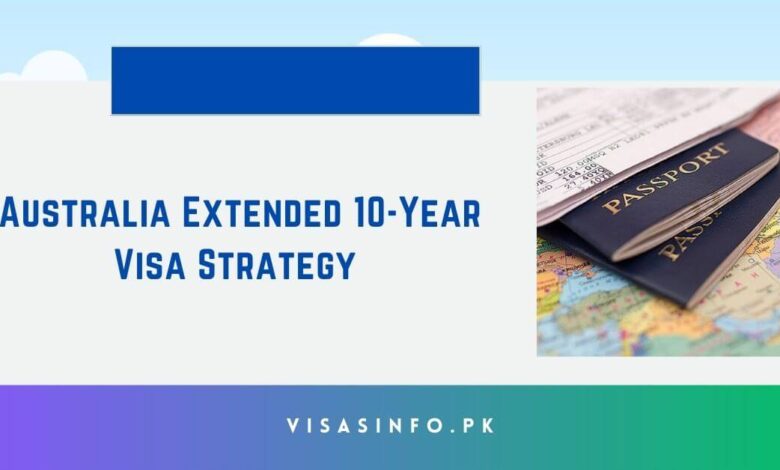Australia Extended 10-Year Visa Strategy in 2024

Employer-sponsored visas have been expedited in Australia for specific professions. Determine whether you are fortunate enough to be employed in these disciplines by continuing to read.
The Australian government has declared that it will prioritize employer-sponsored visas for the healthcare and education sectors in regional locations. Moreover, a recent ministerial directive has underscored the significance of simplifying the visa application process for companies that employ skilled laborers in regional Australia.
The New Direction has resulted in the Department of Home Affairs giving employer-sponsored visa applications top priority for all occupations in Regional Australia. This reform primarily benefits regional firms in Australia, which are still grappling with severe skills shortages in all industries and sectors.
The department also stated that all jobs in regional Australia would be given high priority under these Visa categories to address a recognized shortfall.
- Subclass 482: Temporary Skill Shortage
- Subclass 186 of the Employer Nomination Scheme
- Skilled Employer-Sponsored Regional Provisional Subclass 494
Additionally, the processing of employer-sponsored visas for healthcare and education in regional Australia continues to be a top priority. The department spokeswoman indicated that the processing timelines for the healthcare and education sectors will be minimally affected by this priority transfer, as a result of the reduction in the visa backlog.
How many visas were granted in the healthcare and education sectors?
The Department of Home Affairs authorized 6,466 visas to social workers and healthcare workers under the Temporary Skill Shortage Subclass 482 Visa category in the program year 2022–2023. This was done to ensure that the healthcare industry remained the top applicant pool for both temporary and permanent skilled visas.
Furthermore, nearly 1,060 visas were approved for the education and training sector. Finally, the government confirms that these Visa awards were established based on industry-specific invitation rounds.
4 Important Australia Visa Changes in 2024
In 2024, there are substantial modifications to Australia’s immigration and education policies. These advancements are substantial for experienced professionals and aspiring students who are seeking opportunities in Australia.
This article will emphasize the substantial modifications to Australian immigration visas that will be implemented in March 2024. These changes are intended to simplify visa procedures, modify pathways for international students, and regulate immigration quotas.
1. Update to Australia AC Skill Assessment
The Australian government intends to modify the ACs legislation in light of the recent announcement by the ACs Talent Assessment Authority in March 2024. If you are an IT engineer or data scientist who is considering relocating to Australia, you should be cognizant of this new law, as the new AC’s migration skills evaluation will be implemented.
The updated and revised assessment application platform will provide additional applicant support and a more straightforward assessment process. AC has realized that it is necessary to expedite and simplify the assessment of the migration skills of new candidates. Applications that have already been submitted will receive their results more promptly as a result of the streamlined procedure, and applicants will receive more comprehensive guidance throughout the application process.
2. Age Limit Reform for Australia 485 Visa
The government has officially announced that the age limit of 35 years for 485 Visas will be implemented in the middle of 2024. Additional information will be disclosed before its implementation. A significant number of individuals have been discouraged by the highly controversial and concerning proposal to lower the age threshold for the 485 temporary graduate visa from 50 to 35.
If you are already studying in Australia or plan to do so to obtain a 485 Visa, it is important to monitor any additional developments related to this change. This disparity is the result of the government’s proposed amendment to reduce the age requirement for 485 visas to 50 and the age limit for skilled migration PR visas to 45.
If the recently proposed age restriction of 35 for the 485 Visa were to be implemented, there would be a substantial 10-year disparity between the ages of 35 and 45. This is not per the age restriction for qualified migration visas. An age range of 42 to 45 would be more suitable, as the 485 Visa’s duration would be extended to two or three years.
Furthermore, the government is making an effort to resolve the issue of persistent temporariness, which is frequently referred to as VISA hopping. This phenomenon occurs when an applicant is left with no additional immigration options after their 485 Visa expires.
3. Extension of the 10-year Frequent Traveler Visa Scheme
Timor Leste and other eligible countries are being considered for inclusion in Australia’s 10-year Frequent Traveler Visa program. The planned expansion of Australia’s long-term Visa program, which would enable travelers from Southeast Asian countries to travel without any hassle for up to 10 years, is expected to enhance the country’s tourism industry.
Furthermore, Australia intends to enhance commercial and investor relations by shortening the duration of its business visas from three to five years. Under the 10-year Visa scheme, China was initially permitted to visit Australia.
Numerous Chinese travelers are choosing to visit neighboring Southeast Asian countries, such as Thailand and Malaysia, to access the substantial population of the world’s second-largest economy, due to their visa-free travel laws. Therefore, Australia is bypassing the opportunity to travel to China.
4. End of 2-year Extension of Post-Study Work Rights
For more than a year, international graduates have been granted the opportunity to extend their post-study employment privileges. This enables them to extend the validity of their temporary graduate visa for an additional two years, provided that their degree is in a field with evidence of skill shortages.
The extension has been reevaluated in light of the migration plan’s supplementary considerations and the changing economic landscape of Australia. As a result, graduates of foreign higher education programs will be ineligible to petition for the extension starting in mid-2024.
International graduates who possess an Australian qualification and satisfy the Australian study requirement are still eligible for the temporary graduate post-study work stream. Please contact the Department of Home Affairs with any additional inquiries regarding this modification.
Check Also: Australia Skills In-demand Visa – Apply Now
Benefits of Australia Extended 10-Year Visa
- Long-Term Stay: The visa enables parents to remain in Australia for a maximum of 10 years, allowing them to spend more time with their family and make long-term visits without the need for frequent renewals or exits.
- Flexibility of Multiple Entry: This visa is a multiple-entry visa that enables parents to travel in and out of Australia as necessary, providing a greater degree of flexibility for those who must maintain connections with their home country.
- No Work Restrictions: Although this visa does not provide work privileges, it does not prevent parents from participating in volunteer activities or providing financial support to their family while contributing to the household in non-financial ways.
- Ease of Access for Elderly Parents: The visa is intended to provide comfort to families that prioritize the preservation of close-knit family relationships by enabling elderly parents to remain near their children and descendants.
- Bridge to Permanent Residency: Although the Subclass 870 visa does not directly result in permanent residency, it is a valuable alternative for parents who are awaiting a more permanent solution or for those who wish to remain in Australia for an extended period without the immediate pressure of applying for permanent residency.
- Absence of Offshore Waiting: The Subclass 870 visa is unlike other visas in that it does not necessitate parents to leave Australia to apply for or await a visa decision. This is especially advantageous for individuals who are already in the country.
- Adult Children’s Assistance for Aging Parents: This visa allows adult children to offer their aging parents more consistent care and support, particularly if they are experiencing health issues or simply wish to enhance their family relationships.
- No Impact on Medicare: The Australian healthcare system is not subject to any additional strain as a result of the Subclass 870 visa holders’ ineligibility for Medicare. This may facilitate the process of obtaining private health insurance.
- Family Unity: The capacity to reside together in Australia fosters more robust family relationships, allowing parents to actively engage in the upbringing of their descendants and attend significant family events.
- Access to Australia’s Safe and Stable Environment: Australia’s high quality of life, which includes a safe environment, excellent public amenities, and a high standard of living, makes it an appealing destination for extended stays.
Frequently Asked Questions:
-
Can I get a 10-year Australian visa?
You can receive the visa for up to 10 years. Stay up to 3 months each time you enter.
-
Can an Australian visa be extended?
Apply for a visa to extend your stay.
If you want to stay longer in Australia, get another visa. This may be another visitor visa or another substantive visa. These may include temporary visas such as a work visa (Subclass 482) or a student visa (Subclass 500). -
Is it easy to extend a work permit in Australia?Yes. Anyone in their second year of a work and holiday visa can apply for a 12-month extension if they complete an extra six months of specified work in regional areas of Australia.



